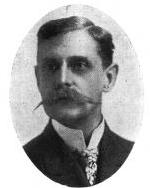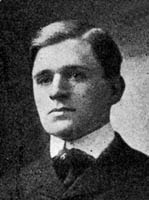Architects, Engineers, & Scientists of the Boston-Edison Historic District
Clarence E. Day
Clarence E. Day was born in 1886 in Detroit. Starting in 1905, he apprenticed at several area architectural firms, then opened his own practice in 1915, specializing in eclectic revival homes. His crowning achievement was likely the Neo-Tudor Scripps Mansion in Lake Orion. With the onset of the Depression, the private home business declined, and Day shuttered his practice in 1935. Working out of his home, he focused on large-scale residential projects. Business picked up in 1937, and he re-opened his practice. Day began collaborating with Harley and Ellington, Inc, and in 1939 merged firms to form Harley, Ellington, and Day (now Harley Ellis Devereaux). Day remained a partner in the firm until 1959.
Clarence E. Day lived at 2235 Edison in the 1920s and 1930s.
Read an extensive history of Harley Ellis Devereaux.
Harold Slaight Ellington

Harold Ellington was born in Chicago in 1886. He completed his schooling there, then attended the Armour Institute of Technology (now ITT), from which he graduated with a civil engineering degree in 1908. He engaged in engineering work in Chicago, then in railroad engineering work in Ludington, before coming to Detroit in 1912 to work as construction engineer for Stroh Brewery. In 1919, Ellington joined the prominent architectural firm of Giaver, Dinkelberg, and Ellington. That partnership, although successful, dissolved after four years and Ellington partnered with William C. Weston. Weston and Ellington designed such large-scale projects as the Metropolitan Building, the Wardell (now the Park Shelton), and the Fort Wayne Hotel.
However, the Depression hit the construction industry hard, and Weston died in 1932. In 1933 Ellington partnered with Alvin Harley to form Harley and Ellington, Inc. (now Harley Ellis Devereaux). Ellington worked as managing partner and president of the firm until retiring in 1965. With the repeal of Prohibition and Ellington's earlier experience at Stroh's, the firm began with brewery buildings, but soon took on other projects, and in 1939 added Clarence E. Day as a partner. Ellington took part in the design of a number of large Detroit buildings, including the Book Building, Stroh Building, and the Real Estate Exchange Building.
Harold Slaight Ellington lived at 2050 Longfellow during the 1930s.
Read an extensive history of Harley Ellis Devereaux.
Elijah Mark Houghton, M.D.
E. Mark Houghton was born in New York in 1867. He came to Michigan in 1889 to attend the University of Michigan, obtaining degrees in both pharmaceutical chemistry and medicine. After his graduation in 1893, he began practice in Ann Arbor and continued to pursue research at the University. In 1895, Parke-Davis hired Houghton and Charles McClintock to establish a biology research lab, with the aim of developing and producing an anti-toxin to diphtheria, then a major public health scourge. They succeeded within a few months, and Houghton remained as Director of Medical Research at Parke-Davis, as well as lecturing at Detroit Medical College and the University of Michigan.
In 1905, Houghton moved into 680 Longfellow, one of the first homes in Boston-Edison, where he lived until the late 1930s.
Nathan Johnson
 Nathan Johnson was born in 1925, and grew up in Kansas. He showed an artistic bent at a young age, and was much influenced by architect Paul Revere Williams, the first licensed African American architect west of the Mississippi. After a stint in the Navy, Johnson attended Kansas State University, graduating with a degree in architecture in 1950. He was unable to find work at the large white architectural firms in Kansas, so he moved to Detroit to take a position with Don White, who was the first Black registered architect in the state of Michigan. Johnson opened his own firm in 1956, with an emphasis on designing churches, the most notable being his addition to the Second Baptist Church on Monroe and the Bethel A.M.E. Church on St. Antoine.
Nathan Johnson was born in 1925, and grew up in Kansas. He showed an artistic bent at a young age, and was much influenced by architect Paul Revere Williams, the first licensed African American architect west of the Mississippi. After a stint in the Navy, Johnson attended Kansas State University, graduating with a degree in architecture in 1950. He was unable to find work at the large white architectural firms in Kansas, so he moved to Detroit to take a position with Don White, who was the first Black registered architect in the state of Michigan. Johnson opened his own firm in 1956, with an emphasis on designing churches, the most notable being his addition to the Second Baptist Church on Monroe and the Bethel A.M.E. Church on St. Antoine.
In 1962, Johnson was commissioned to design a residence for restaurateur Stanley Hong on the corner of West Boston and Hamilton. Hong later commissioned Johnson to design the "Googie-style" Mannia Cafe on Baltimore in 1969. Johnson also designed works for the Detroit Board of Education, as well as People Mover stations, the University Towers apartment building, Eastland Shopping Center, and Shed 5 at Eastern Market. He retired in 2000, and received an AIA Gold Medal in 2018. He died in 2021.
Nathan Johnson lived at 803 W. Boston (previously the home of Harry Stormfeltz, Vincent Giuliano, and Edward Baker) from 1969 until 2006.
Richard H. Marr

Richard H. Marr was born in Detroit in 1886; he attended Harvard and received a degree in architecture in 1911. After practicing for two years in Boston, Marr returned to Detroit, where he specialized in designing homes and apartment houses in Detroit and its suburbs. Many of his homes were very upscale, built in Indian Village, Palmer Woods, and Boston-Edison (for example, the house on West Boston he designed for Edward Fisher). Two of his projects - the Architect's Building and the Palmer Park Boulevard Apartments District - are on the National Historic Register of Places. Richard Marr died in 1946.
Richard H. Marr lived at 1186 Edison from the late 1910s until the late 1940s.
William G. Malcomson

William G. Malcomson was born in 1856 in Hamilton, Ontario. He began his architectural career early, and in 1875 supervised the construction of the Henry Langley-designed Erie Street United Church in Ridgetown, Ontario. In 1890, Malcomson formed a partnership with William E. Higginbotham. The firm of Malcomson and Higginbotham was retained by the Detroit Board of Education in 1895, and between 1895 and 1923 had designed over 75% of the school buildings in Detroit, including the 1895 Central High School (now Wayne State University's Old Main) and the 1917 Cass Tech, as well as multiple other architecturally significant buildings in Michigan. His architectural firm still exists as "Malcomson-Greimel and Associates."
William G. Malcomson lived at 61 Edison from the early 1920s until his death in 1937.
Read about Malcomson and Higginbotham on Wikipedia.
Emil C. Pokorny
Emil Pokorny was born in Detroit in 1877. He left school after the eighth grade to become a sheet metal former; however, he continued his studies in night school. In 1902, with the encouragement of his wife Ida, he entered Michigan Agricultural College (now Michigan State University), graduating in 1907 with a degree in mechanical engineering. After leaving school, Pokorny spent time as a HVAC engineer, then went into business for himself as a builder and general contractor under the name Pokornoy & Co., Pokornoy specialized in building small apartment buildings, but also constructed private homes and stores.
Emil Pokorny lived at 849 Edison in the 1920s.
William Pitt Putnam
William Pitt Putnam was born in Belpre, Ohio, in 1870. He received a BS from Buchtel College in 1893, and began work in chemistry in Cleveland, later moving to Pittsburgh to take up mining engineering with Pittsburgh Steel & Iron. In 1897, he moved to Detroit, working for two steel companies. In 1903, he organized the Detroit Testing Laboratory, a business that still exists today. Putnam served as president and general manager until his retirement, leaving only to serve as a Major in Ordnance Department of the Army during World War II.
William Pitt Putnam lived at 1419 Edison in the 1930s and 1940s, in the house built by Andrew Jay Weatherwax.
Hartley Rowe

Hartley Rowe was born in 1882 in Goodland, IN. He attended Purdue University, graduating in 1904 with a degree in electrical engineering. From 1908 to 1917, he worked on the Panama Canal project. After leaving Panama, he was recruited by Lockwood Greene, an engineering firm, to head their local office in Detroit. He later joined the United Fruit Company as chief engineer, eventually becoming vice president and director of the company. During WWII, Rowe took part in the Manhattan Project, helping with the transition of the atomic bomb from research to production. In 1946, President Truman appointed Rowe (along with Robert Oppenheimer and Enrico Fermi) to the General Advisory Committee to the Atomic Energy Commission, where Rowe (along with Oppenheimer and most other commission members) argued against the production of the H-bomb.
Hartley Rowe lived at 875 Edison in the early 1920s.
Nat Weinberg
Nat Weinberg was born in New York in 1914. He attended Brookwood Labor College in 1935, where he met Walter Reuther. He received a BA in economics from New York University in 1942. He worked in several federal jobs until 1947, when Reuther invited him to join the UAW as Research Director. While there, he formulated the idea if a guaranteed annual wage, and supplemental employment benefits, both of which were utilized in negotiations with automakers. In 1957, Weinberg was named the Director of Special Projects and Economic Research at the UAW, a position he held until he retired in 1973. Weinberg died in 1985.
Nat Weinberg lived at 2234 Longfellow from the 1940s through the 1960s.

